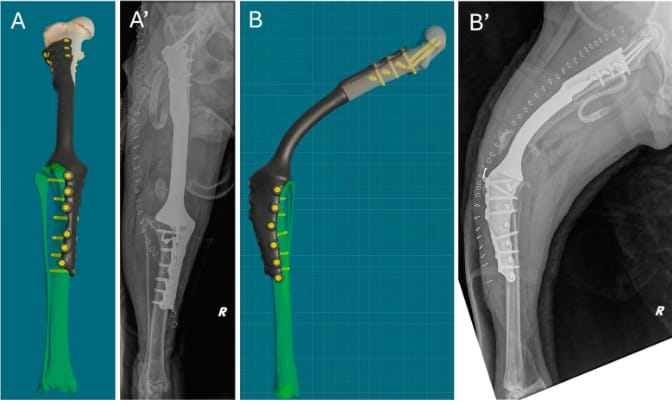- Veterinary View Box
- Posts
- Revolutionizing Canine Bone Cancer Treatment: A Case Study on 3D-Printed Limb-Sparing Surgery
Revolutionizing Canine Bone Cancer Treatment: A Case Study on 3D-Printed Limb-Sparing Surgery
Animals 2025
Enrico Panichi, Marco Tabbì, Gaetano Principato, Valentina Dal Magro, Fabio Valentini, Marco Currenti, Francesco Macrì
Background
Chondrosarcoma is the second most common primary bone tumor in dogs, with amputation often considered the standard treatment. However, concerns over quality of life and pre-existing orthopedic conditions can make limb-sparing alternatives more desirable. This study presents a case of an eight-year-old Golden Retriever with distal femoral chondrosarcoma treated using a patient-specific 3D-printed guide and endoprosthesis to improve surgical precision and recovery outcomes.
Methods
A preoperative CT scan was used for virtual surgical planning (VSP), enabling the design of patient-specific cutting guides (PSGs) and a titanium endoprosthesis (PSE). Surgery involved tumor resection via ostectomy, prosthetic implantation, and stifle arthrodesis. Postoperative care included pain management, antibiotics, and rehabilitation. Follow-ups were conducted at 3, 6, 12, and 18 months.
Results
The PSG and PSE fit precisely, reducing intraoperative time and complications. The dog bore weight within 48 hours and exhibited stable mobility at follow-ups. No infection, limb misalignment, or tumor recurrence was observed up to 18 months post-surgery. The case highlights the efficacy of 3D-printed implants in maintaining limb function and quality of life.
Limitations
Follow-up radiographs were not performed due to owner constraints, limiting assessment of implant integrity. The study represents a single case, necessitating larger studies to confirm findings.
Conclusions
3D-printed PSGs and PSEs enabled precise tumor resection and reconstruction, reducing surgical time and enhancing postoperative recovery. This case underscores the potential of personalized 3D-printed implants in veterinary surgical oncology, offering an alternative to limb amputation for select patients.

Comparison of virtual surgical planning and postoperative radiographs. (A,A’) Cranial view. (B,B’) Lateral view.
How did we do? |
Disclaimer: The summary generated in this email was created by an AI large language model. Therefore errors may occur. Reading the article is the best way to understand the scholarly work. The figure presented here remains the property of the publisher or author and subject to the applicable copyright agreement. It is reproduced here as an educational work. If you have any questions or concerns about the work presented here, reply to this email.